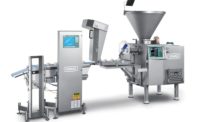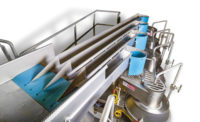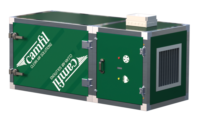Numerous industries throughout the world—aerospace, automotive, construction and manufacturing, to name just a few—already rely on robots to produce goods more accurately, quickly and cost-effectively than their human counterparts. Such attributes and others are sure to continue driving sales of robots in these industries, as well as advance their use by other manufacturers, including food, in the coming years.
Increasing plant efficiency
“The International Federation of Robotics (IFR) reports that 178,132 industrial robots were sold worldwide in 2013, of which 6,200 were destined for the food and beverage industry,” says Eric Aasen, product manager, Bosch Packaging Technology, New Richmond, WI. “We expect to see increased growth in automation within small and medium-sized companies throughout 2016 and beyond.”
Aasen attributes the increased use of robotics to the technology’s ability to enhance productivity and flexibility. “Due to the nature of the bakery and snack food industries, product and volume requirements change quickly, and often multiple product types, sizes and package styles need to be handled on the same machine,” he says, noting that his company’s flexible and scalable solutions support its customers in adapting to these changes and helping them achieve their goals.
Aasen adds that robotic equipment also offers manufacturers the benefit of 24/7 performance, enabling them to significantly increase their production and achieve a cost-per-unit reduction, which provides them with a competitive advantage.
Rick Hoskins, president of Colborne Foodbotics, Lake Forest, IL, also sees robotic automation increasing in the baking industry. “Robotics is still a relatively new automation solution to the baking industry compared to other industries,” he says. “While early adopters have focused their implantation on the packaging area, there are still many applications that remain highly labor-intense, but given the complexity and flexibility, the financial hurdles have not quite been met.”
Increasing wages and other labor-related costs and an improving economy will likely boost the implementation of robotics, Hoskins says, especially for projects considered to be “on the bubble of acceptable financial returns. We also believe that as the sanitation features of robots continue to improve, we will see new applications in the makeup area of robotics that today are not being considered.”
Martin Riis, sales manager, Unifiller Systems, Delta, British Columbia, says: “Robots have been used for years in the packing of products, but it is quite new that robots are being used to create the actual product. I think we will see a lot of growth in this area over the coming years, as the technology develops and becomes more accessible.”
Robot misconceptions
Despite equipment manufacturers’ optimistic outlook for the growth of robotics in the baking and snack industries, they know they still must address some misconceptions about robots by some bakers and snack producers.
“Bakers are very concerned about whether or not a current labor pool can support robotic systems,” says Hoskins. “Projects that involve first-time users of robotics always involve some discussion about how to support the robot from a maintenance and operation standpoint. The bottom line is that the robot itself—with little training—is easier to troubleshoot than complicated PLCs and highly electromechanical systems.” He adds that robot manufacturers have a wide range of training options to teach customers how to operate and maintain the robot itself.
Many bakers and snack producers are also concerned that robotic systems are advanced beyond their scope of accessibility, notes Aasen. “It’s possible, however, to draw a parallel to the introduction of the first servo-driven generation of horizontal flow wrappers,” he says. “While we now embrace servo-driven machines as an industry standard, this wasn’t always so, as the industry needed time to accept and integrate this newer technology. At Bosch, we expect to see robotics follow a similar path and, in time, become the new industry standard.”
Eugeni Beoriegui, sales manager, BEOR, Barcelona, Spain, emphasizes that bakers must lose their fear of robotic technology given the efficiencies that such technology can bring.
Robots today
Bakers and snack manufacture/rs ready to venture into robotics will find equipment capable of performing a variety of specific tasks.
Unifiller Systems has used robots for many years to automate cake production, from simple cake stacking to 3D surface-scanning to apply intricate decorations on top of cakes, says Riis. Its Deco-Bot, a compact, multi-axis robot, performs multiple decorating applications typically done by humans—from drizzling chocolate to creating butter cream swirls to drawing fine artwork on top of cakes.
Despite its small footprint, the Deco-Bot can carry up to 35 pounds and offers bakers and snack manufacturers numerous benefits, according to Riis, including that it creates consistent products every time. Because it performs most repetitive applications, it helps bakers shield employees from the risk of repetitive-stress injuries. It increases productivity by generating consistent, finished products faster and more efficiently than people over a longer time period.
Unifiller Systems has also developed a simple-to-use interface based on a PC tablet. “With this software, you can quickly draw on the tablet what you would like to see on a cake—for example, ‘Happy Birthday’ with a little teddy bear beside it,” explains Riis. “The text can be one color, and the bear in another. This is due to Unifiller’s extensive knowledge of how icing flows and reacts once it is applied with our specially designed decoration nozzles.”
Available from Bakery Concepts International LLC, Enola, PA, BEOR’s automated Leonardo water scorer offers bakers with a bladeless method of scoring fermented or unfermented dough, as well as dough with high and low hydration levels. “Sometimes workers cannot move boards or trays from the trolley to the bread line or score bread all time without harming their health,” says Beoriegui. “For that reason, it is better to install a robot.”
The system features a photoelectric cell laser that automatically adjusts with height variations, a human-machine interface (HMI) with a touchscreen that can store recipes and three types of scoring—herringbone, crisscross and straight.
Colborne Foodbotics’ newest robotic system has eight points of interface serviced by a single robot, says Hoskins. Designed for producing croutons and stuffing mix, it features three infeed systems that accept incoming stacks of loaded baskets and one outfeed conveyor that accepts empty baskets, which are stacked and released to a dolly loading system.
The control system self-monitors recipes and operates the robot to locate the various bread loaves based on the flavors required to produce the final products. The robot picks up a basket loaded with 10 loaves of dried bread, carries it to the stacker where it is placed on the stack, and then carries the loaves to one of the three output conveyors leading to the cubing process. “This system is a perfect example of how a single robot can be fully utilized,” says Hoskins.
The D3 robotic platform for primary and secondary packaging, Bosch Packaging Technology’s most recent development, represents the newest generation of Delta robots, says Aasen. “The redesigned D3 robotic platform handles higher payloads of up to 6.5 pounds (3 kilograms) and ensures faster speeds to increase pick rates for a wide range of applications,” he explains.
Designed with fewer and more standardized parts, the platform allows for quick changeovers and simplified use and maintenance. In addition, it features a hygienic, open-frame design that simplifies cleaning and maintenance, enabling manufacturers to better comply with increasingly stringent food-safety regulations.
“Automated solutions like the D3 Delta robotic platform are providing a faster and safer alternative to operations that were formerly performed manually, such as picking and placing of delicate bakery and snack food items,” says Aasen. “When delicate products, such as baked cookies or tortillas, are handled manually or with nonrobotic solutions, there is a greater risk for product breakages, resulting in wasted products. Combined with the benefit that the machines perform consistently, for 24 hours a day, manufacturers can increase production, resulting in a lower cost-per-unit and a competitive advantage. Also, it allows companies to reallocate staff to perform higher-level tasks, while also eliminating operating errors.” He adds that robotics also minimize the risk of product contamination by limiting human contact with products.
Robots tomorrow
What kind of innovations can bakers and snack manufacturers expect to see next in robotic equipment for the baking and snack industries? Beorlegui cites easy-to-use programs. “To program a robot, you need technical engineer, which is not cheap,” she says. “I think that in the future, any person will be able to program one.”
Bosch has noticed a trend toward complete line solutions versus standalone machines, says Aasen. “Therefore, we design solutions to address this need,” he explains. “This has also led us to focus our developments and expertise on creating modular and scalable solutions for easy line automation, suited to small and medium-sized, as well as multinational, companies.
“There is great potential for robotic use in secondary packaging to boost manufacturing productivity and flexibility even further,” Aasen continues. “Robotic technology increases speed and output, with primary packaging leaving manufacturers in need of case-packing technologies capable of keeping up with the high throughput. Line synchronization is critical for minimizing bottlenecks and maximizing uptime.”
From production to packaging, bakers and snack producers can already choose from a variety of robotics equipment to make their operations more efficient, productive and competitive. Robotics manufacturers are ready to help them make the most of it.







